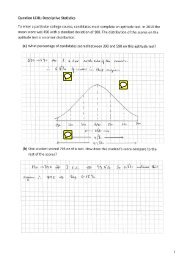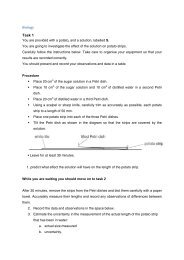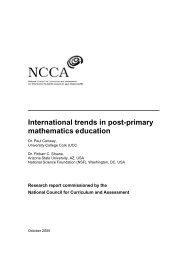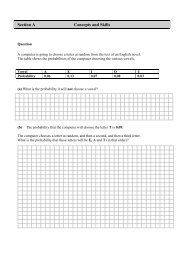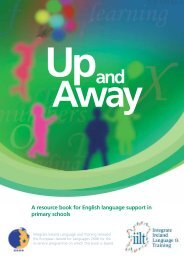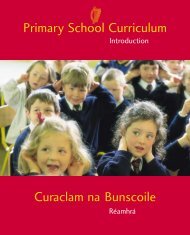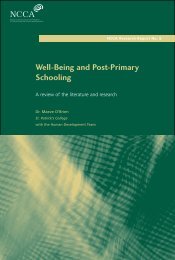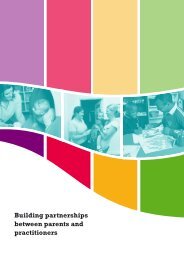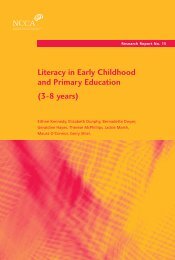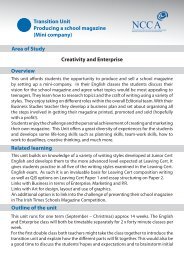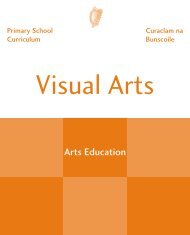Visual Arts - NCCA
Visual Arts - NCCA
Visual Arts - NCCA
Create successful ePaper yourself
Turn your PDF publications into a flip-book with our unique Google optimized e-Paper software.
The concept of balance permeates the curriculum,<br />
with its carefully weighted emphasis on making on<br />
the one hand and looking at and responding on the<br />
other. Such a balance allows students to look within<br />
and beyond, to absorb, to perceive, and to assimilate<br />
concepts and skills, and by so doing to involve<br />
themselves in expressive and receptive dialogue<br />
with the world.<br />
The visual arts curriculum provides structures through<br />
which the students are encouraged to learn about<br />
themselves and the world around them. It is organised<br />
in six strands:<br />
n<br />
n<br />
n<br />
n<br />
n<br />
n<br />
drawing<br />
paint and colour<br />
print<br />
clay<br />
construction<br />
fabrics and fibre.<br />
Through the six strands, the student is offered the<br />
opportunity to explore qualities and characteristics<br />
of materials, find solutions to design problems,<br />
communicate, reciprocate, and make sense of<br />
experiences.<br />
Strands<br />
Drawing<br />
The visual arts can be seen as a communication<br />
system in its own right. Drawing is central to the<br />
language of art. Mark-making is one of the first<br />
outward presentations made by most young children.<br />
The student who develops confidence in drawing and<br />
gains an understanding that graphic representations<br />
symbolise and convey meaning can enjoy the<br />
multitude of uses of this strand. Drawing can be<br />
employed as a means of expressing and recording<br />
ideas, experiences, imaginings, observations, and<br />
feelings. It may also be possible to interpret and use<br />
such expression.<br />
Paint and colour<br />
Colour pervades the world of the student. Perception<br />
is developed and broadened when the student learns<br />
to focus on the nature and dimension of colour.<br />
Discovering the spectrum of colours, the meaning and<br />
symbolism to be found in colour, and the potential for<br />
Guidelines Mild General Learning Disabilities / <strong>Visual</strong> <strong>Arts</strong> / PRIMARY<br />
finding pleasure in responding to and using colour can<br />
provide the student with essential lifelong skills. Paint<br />
is an excellent medium for such investigation. It is a<br />
catalyst for perceptual and conceptual learning.<br />
Print<br />
From footprints in the snow to photography to the<br />
money that we use to the design on the breakfast<br />
cereal box, printing encompasses the life of the<br />
student on many levels. The breadth of learning that<br />
can happen through this strand of the curriculum<br />
is vast. The process of print-making allows for the<br />
exploration of cause-and-effect, pattern, mass<br />
production, understanding of positive and negative,<br />
shape and line, and the creative potential of random<br />
marks. A wide range of techniques can be used, such<br />
as printing with found objects, relief prints, stencils,<br />
rubbings, monoprints, making patterned prints for<br />
wrapping paper, cards, and posters. (See the Primary<br />
School Curriculum.)<br />
Clay<br />
Clay offers the student a range of possibilities. Its<br />
malleable quality renders it ideal for the manipulation<br />
of form and the exploration of texture. In clay the<br />
student can find a springboard for creative expression<br />
that can liberate him/her from the purely conceptual<br />
aspects of the curriculum. This encourages greater<br />
perceptual learning. Clay provides clear opportunities<br />
for the student to learn about features of visual<br />
arts that pertain to the functional aspect of art, the<br />
expressive potential of art, and the importance of the<br />
processes of designing and making art.<br />
Construction<br />
In learning about construction the student is the<br />
architect of his/her own expression. Through this<br />
strand the student learns how things are made, how<br />
they balance, how things fit together, how things<br />
support each other, and how the environment<br />
is affected by architectural planning. He/she is<br />
encouraged to become aware of how some things<br />
enhance our environment while other things detract<br />
from it. The student is facilitated to find personal<br />
expression in constructing, inventing and manipulating<br />
in 3D. The qualities, limitations and potential of a<br />
variety of materials are explored. This strand is ideally<br />
suited to group projects and collaborative learning,<br />
and integrates extremely well with work in shape and<br />
space in mathematics or with work in designing and<br />
making in science.



